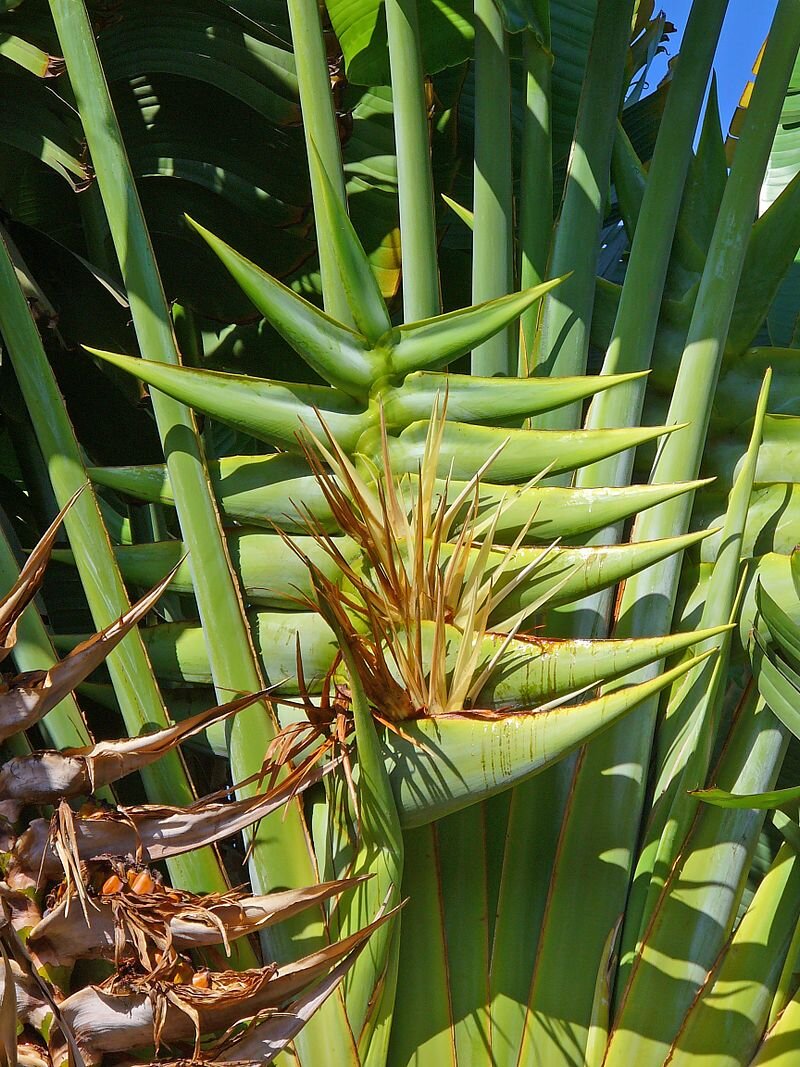© CEphoto, Uwe Aranas licensed under CC BY-SA 3.0
This nifty looking tree is commonly referred to as the traveler's palm (Ravenala madagascariensis). In reality, it is not a palm at all but rather a close cousin of the bird of paradise plants (Strelitziaceae). It is endemic to Madagascar and the only member of its genus. Even more fascinating is its relationship with another uniquely Madagascan group - the lemurs. But first we must ask, what's in a name?
The name "traveler's palm" has two likely explanations. The first has to do with the orientation of that giant fan of leaves. The tree is said to align its photosynthetic fan in an east-west orientation, which can serve as a crude compass, allowing weary travelers to orient themselves. I found no data to support this. The other possibility comes from the fact that this tree collects a lot of water in its nooks and crannies. Each of its hollow leaf bases can hold upwards of a quart of rain water! Get to it quick, though, because these water stores soon stagnate.
Photo by H. Zell licensed under CC BY-SA 3.0
Flowers are produced between the axils of the leaves and closely resemble those of its bird of paradise cousins. Closer observation will reveal that they are nonetheless unique. For starters, they are large and contained within stout green bracts. Also, they are considerably less showy than the rest of the family. They don't produce any strong odors but they do fill up with copious amounts of sucrose-rich nectar. Finally, the flowers remain closed, even when mature and are amazingly sturdy structures. It may seem odd for a plant to guard its flowers so tightly until you consider how they are pollinated.
It seems fitting that an endemic plant like the traveler's palm would enter into a pollination syndrome with another group of Madagascar endemics. As it turns out, lemurs seem to be the preferred pollinators of this species. Though black lemurs, white fronted lemurs, and greater dwarf lemurs have been recorded visiting these blooms, it appears that the black-and-white ruffed lemur manages a bulk of the pollination services for this plant.
Watching the lemurs feed, one quickly understands why the flowers are so stout. Lemurs force open the blooms to get at the nectar inside. The long muzzles of the black-and-white ruffed lemur seem especially suited for accessing the energy-rich nectar within. The flowers themselves seem primed for such activity as well. The enclosed anthers are held under great tension. When a lemur pries apart the petals, the anthers spring forward and dust its muzzle with pollen. Using both its hands and feet, the lemur must wedge its face down into the nectar chamber in order to take a sip. In doing so, it inevitably comes into contact with the stigma. Thus, pollination is achieved. Once fertilized, the traveler's palm produces seeds that are covered in beautiful blue arils.
Photo by Jeffdelonge licensed under CC BY-SA 3.0
All in all, this is one unique plant. Though its not the only plant to utilize lemurs as pollinators, it is nonetheless one of the more remarkable examples. Its stunning appearance has made it into something of a horticultural celebrity and one can usually find the traveler's palm growing in larger botanical gardens around the world. Though the traveler's palm itself is not endangered, its lemur pollinators certainly are. As I have said time and again, plants do not operate in a vacuum. To save a species, one must consider the entirety of its habitat. This is why land conservation is so vitally important. Support a land conservancy today!



![[SOURCE]](https://images.squarespace-cdn.com/content/v1/544591e6e4b0135285aeb5b6/1508201752975-7W5T194C1IK9IC4ZE62M/batpass1.JPG)
![[SOURCE]](https://images.squarespace-cdn.com/content/v1/544591e6e4b0135285aeb5b6/1508203341477-I655ZRIK84ZNM78XLMYE/image-asset.jpeg)









![Overviews showing the tentacle-free adaxial surface and tentacles along the leaf margins (B & C). (D) Partial leaf tip showing different size classes of stalked glands. [SOURCE]](https://images.squarespace-cdn.com/content/v1/544591e6e4b0135285aeb5b6/1574712995157-PDQXZKTLFXOY7MEJ3YGJ/camb3.JPG)
